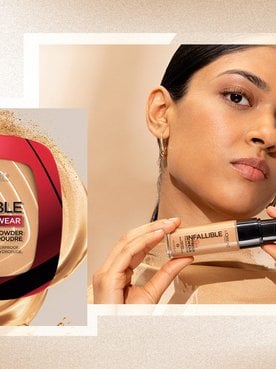Finding the right ingredient to elevate your skincare routine can make all the difference, and glycolic acid is one of our favorites. As you may know, there’s a lot of hype around glycolic acid benefits for skin, and we’d say that’s warranted. Glycolic acid products can brighten dull skin, minimize the look of fine lines, and diminish the appearance of dark spots—and that’s just to start. Ahead, we’re sharing everything you need to know about glycolic acid for skin, spilling on the ingredient’s many benefits, and sharing tips on how to incorporate the powerhouse acid into your regular skincare routine.
What is Glycolic Acid?
Glycolic acid is an alpha-hydroxy acid (AHA) derived from sugarcane. According to the Cleveland Clinic, AHAs like glycolic acid help exfoliate, turning over layers of dead skin cells on the surface of your skin. With consistent use, products with glycolic acid can help improve skin texture and tone. While primarily used in skincare, glycolic acid also has applications in other industries—it’s even gaining traction as a worthwhile haircare ingredient.
What does glycolic acid do?
Glycolic acid works as a chemical exfoliant, gently breaking down the bonds between dead skin cells on the skin's surface, allowing them to be easily sloughed away. This process helps reveal fresher, more radiant-looking skin underneath and improves the appearance of skin texture and tone. However, according to the Cleveland Clinic, glycolic acid uses extend beyond simple exfoliation. With consistent use, it can also help encourage collagen production to support a firm, supple complexion.
Who should use glycolic acid?
Anyone looking to improve their skin’s texture and tone may want to try glycolic acid. This ingredient can be especially useful for individuals with dull, uneven, or sun-damaged skin, as it promotes a more radiant and even-looking complexion. Those struggling with fine lines, wrinkles, or dark spots may also find glycolic acid effective in addressing their skin concerns.
It's important to note that glycolic acid products aren’t one-size-fits-all—there are different concentrations available, from ultra-mild to relatively potent. If you’re new to chemical exfoliants, we generally recommend starting with a lower concentration until your skin acclimates. You can also consult your dermatologist for help pinpointing a formula that suits your skin’s unique needs.
Shop the Product
What Are the Benefits of Glycolic Acid?
Glycolic acid benefits go beyond surface-level improvements, addressing everything from tone and texture to how well your other products perform. Here’s a closer look at the transformations you can expect when incorporating this ingredient into your routine.
1. Brighter-looking skin
As mentioned earlier, glycolic acid is a chemical exfoliant, meaning it encourages skin cell turnover. By helping to clear away dull, dead surface cells, glycolic acid products—such as glycolic acid serums or toners—can help brighten the skin, revealing a more radiant, luminous complexion over time.
2. Faster product absorption
By helping to remove dead skin cells, alpha-hydroxy acids like glycolic acid can help your skin better absorb other skincare products, such as essences, serums, and moisturizers.
3. Fewer wrinkles
One of the best-known glycolic acid serum uses is for anti-aging. When used consistently, products with glycolic acid can help smooth and firm the skin, diminish the appearance of fine lines, and soften deeper wrinkles. Of course, you can’t avoid skin aging completely—but incorporating glycolic acid into your routine can help promote a more youthful appearance.
4. Reduction of dark spots
You can use glycolic acid for dark spots, too. If your skin looks uneven due to the presence of stubborn brown, gray, or reddish marks, consider adding a glycolic acid serum or moisturizer to your routine. According to the American Academy of Dermatology (AAD), this powerful AHA can help resurface your skin, promoting a more even-looking complexion over time.
5. More hydrated skin
Some research suggests that glycolic acid can help hydrate the skin, making it an appealing exfoliant for those prone to dryness. Still, it’s best not to rely on glycolic acid alone to keep your skin hydrated—moisturizing twice daily is still a must (regardless of your skin type). You can see a few of our top picks for dry skin here.
What Are the Risks of Glycolic Acid?
Like any powerful skincare ingredient, it’s important to understand what could go wrong before you dive in. While the glycolic acid benefits are impressive, overuse or misuse can lead to irritation and other unwanted effects. Here are two things to look out for when using glycolic acid.
Redness and irritation
Like all actives, using glycolic acid on your face can cause irritation, especially at higher concentrations. Redness, stinging, or light peeling are common when starting or using it too often. Starting with a low concentration and using it a few times per week helps minimize discomfort.
Increased sun sensitivity
According to the United States Food and Drug Administration (FDA), chemical exfoliants, including glycolic acid, can increase your skin’s sensitivity to sunlight. To protect your skin from unintentional burns or sun damage, be sure to wear a broad-spectrum sunscreen with an SPF of at least 15 every day. Keep in mind that for lasting protection, you’ll want to reapply your sunscreen at least every two hours (more frequently if you’re sweating or swimming). Need a recommendation? We love the L’Oréal Paris RevitaLift Triple Power Moisturizer with SPF 30.
Shop the Product
How To Use Glycolic Acid in Your Skincare Routine
Getting all the glycolic acid benefits means using it thoughtfully and with care. The right approach can maximize the ingredient’s benefits while avoiding irritation, making it easier to maintain a healthy, glowing complexion. Here’s how to integrate it into your day-to-day routine the smart way.
Start with a low concentration
When introducing a glycolic acid serum or toner to your routine for the first time, follow a less is more approach. Begin with a low concentration two to three times a week and see how your skin reacts. If it tolerates well, you can gradually work your way up to a higher-concentration product.
Can you use glycolic acid daily?
Whether or not you can use glycolic acid every day depends on the product you’re using, your skin type, and the rest of your routine. Gentler products, like cleansers, can often be used daily, while more powerful glycolic acid serums may require a less frequent application. Since overexfoliating can damage your skin barrier and cause irritation, it’s extra important to be mindful in your approach. We recommend reading instructions on the product you’re using for guidance, and if you’re still unsure, consult your dermatologist for professional advice.
Always wear sunscreen
We mentioned it above, but it bears repeating: You should always wear sunscreen when using a product with glycolic acid, even if you use said product at night. For extra protection, take other sun-safety measures, too: Avoid direct sunlight at midday, stick to the shade when possible, and cover exposed skin with clothing or accessories (a wide-brimmed sunhat is chic and functional).
How To Choose the Right Glycolic Acid Product For You
With so many formulas and strengths available, finding the perfect glycolic acid products can feel overwhelming. Understanding what each type offers helps you match the right formula to your needs and lifestyle. Here are two of our favorite glycolic acid products worth checking out.
L’Oréal Paris RevitaLift 10% Pure Glycolic Acid Serum
This potent glycolic acid serum contains 10% pure glycolic acid for powerful resurfacing and visible skin renewal. Validated by an external panel of dermatologists, the concentrated formula absorbs quickly to help even skin tone and reduce wrinkles, fine lines, and dark spots. This daily serum is blended with soothing aloe to comfort skin as it works; immediately,skin feels smoother and more refined, and after one week it appears resurfaced and younger-looking. Over time, skin tone becomes more even and visible discolorations are reduced. It’s fragrance-free, paraben-free, mineral oil-free, dye-free, and allergy tested.

L’Oréal Paris Bright Reveal Dark Spot Exfoliant Peel
As we mentioned, using glycolic acid for dark spots can be an effective skincare solution. This exfoliant in particular is one of our favorite options. It’s crafted to visibly fade all types of dark spots and renew skin texture. The formula with a unique blend of AHAs, BHA, and PHA, which takes inspiration from professional peels, provides gentle exfoliation, brightens skin tone, and improves skin texture. After just one use, skin appears instantly brighter and feels retexturized and softer. Plus, the dermatologist-validated peel is suitable for sensitive skin and all skin tones.
Unlike a standard facial serum, this chemical exfoliator is meant for use up to four times per week. Shake the bottle well, then apply evenly to clean, dry skin. Wait 15 minutes, rinse, and follow with moisturizer. And remember, during the day, sunscreen is a must.
Shop the Product
Next Up: 11 Anti-Aging Products To Refresh Your Skin and Fight Wrinkles
Photo courtesy of L’Oréal Paris







